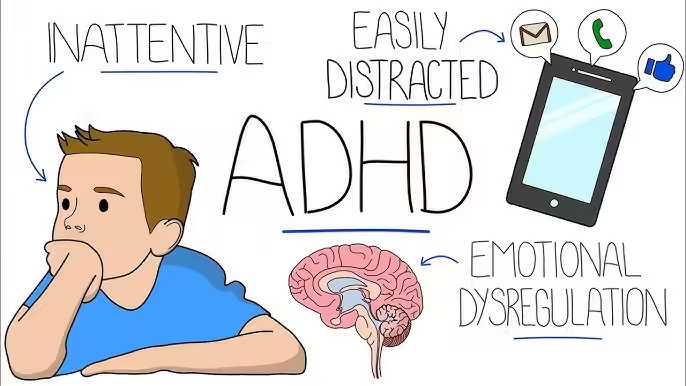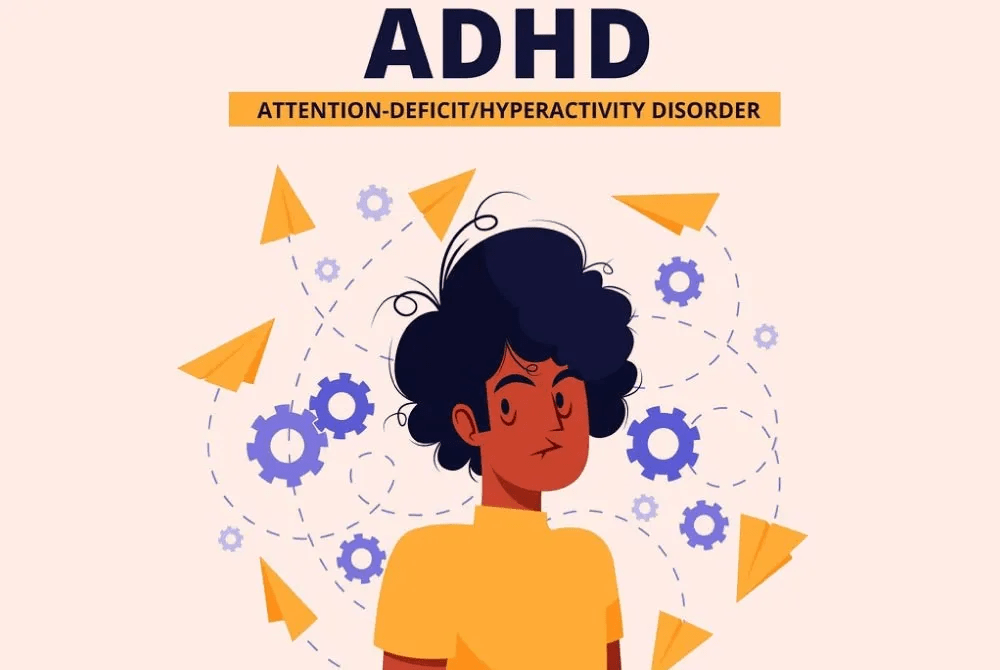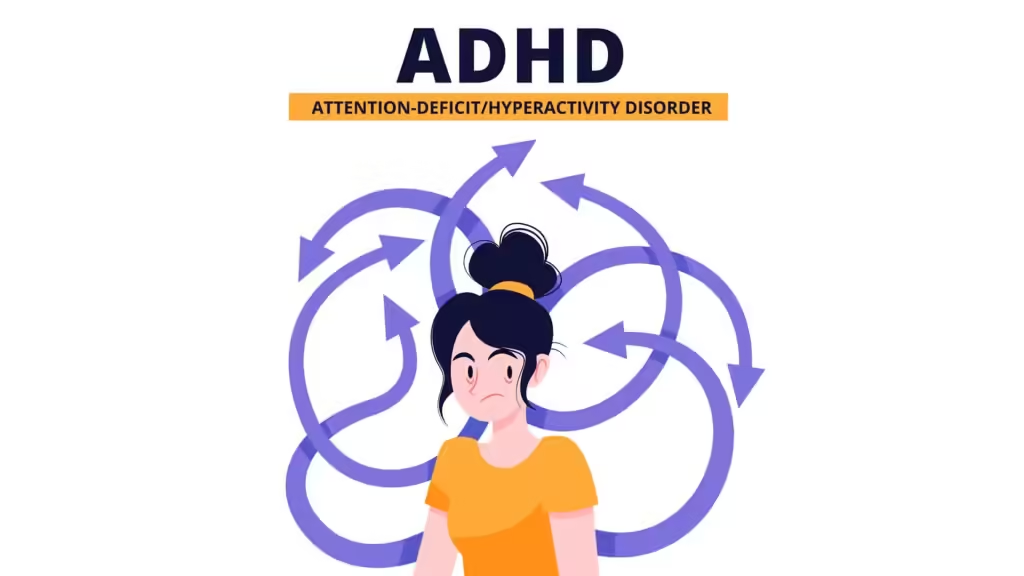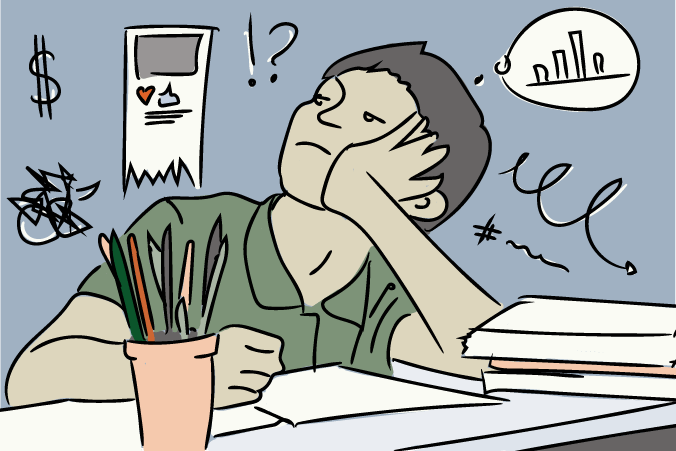Definition of Attention Deficit Hyperactivity Disorder
Attention Deficit Hyperactivity Disorder (ADHD) is a common disorder encountered in child psychiatry clinical practice. In most cases, symptoms of inattention are often combined with hyperactivity disorders.
A prominent feature of this disorder is the patient’s inability to focus on a particular object, topic, or task, constantly shifting their attention to various stimuli, objects, or events in their surroundings. This leads to hyperactivity symptoms, where the patient is always active but unable to complete any given or assigned task.
Etiology
To date, science has yet to identify an apparent cause of Attention Deficit Hyperactivity Disorder (ADHD). However, studies have shown that certain factors significantly impact this disorder.
The etiology of ADHD is related to a variety of factors that include both a genetic and an environmental component.

- Genetic: It is one of the most heritable conditions in terms of psychiatric disorders. There is a much greater concordance in monozygotic twins than dizygotic. Siblings have twice the risk of having ADHD than the general population.
- Environment component: Researchers have also explored viral infections, smoking during pregnancy, nutritional deficiencies, and alcohol exposure in the fetus as possible causes of the disorder.
Symptoms of Attention Deficit Hyperactivity Disorder
Researchers categorize children with Attention Deficit Hyperactivity Disorder (ADHD) into three main subtypes:
- Predominantly inattentive presentation
- Primarily hyperactive-impulsive manifestation
- Combined exhibition.
To diagnose ADHD, these symptoms must be present in at least two different settings, typically at home and school. Some children may exhibit hyperactive behaviors at home, but these behaviors diminish in a more structured environment like a classroom. Therefore, healthcare providers often make the diagnosis of ADHD when a child reaches school age, even though symptoms may manifest earlier.
The core symptoms of ADHD are divided into two groups: (1) hyperactivity-impulsivity and (2) inattention. Younger children often exhibit more hyperactivity-impulsivity, while older children tend to show more signs of inattention.
Inattentive symptoms include not paying close attention to tasks, missing small details, rushing through tasks, not seeming to listen when spoken to, difficulty organizing things, not finishing work, disliking or avoiding tasks that take sustained mental effort, losing things, or being forgetful.
Hyperactive symptoms include fidgeting, feeling like an “internal motor” is always going, leaving their seat, climbing on things, being loud, blurting out answers, talking excessively or out of turn, having trouble waiting their turn, interrupting or intruding on others. These symptoms must be present in multiple settings.

In adults, however, these core symptoms may be missing, and they may manifest as other problems, such as procrastination, mood instability, and low self-esteem. They will likely be more impulsive in nature or inattentive, as the hyperactivity symptoms can be better controlled. Properly taking a history of childhood is likely to reveal symptoms of inattention or hyperactivity that may have been missed otherwise.
Diagnosis
Diagnostic Criteria for Attention Deficit Hyperactivity Disorder (ADHD) According to the Diagnostic and Statistical Manual of Mental Disorders, Fifth Edition (DSM-5)
A child must have at least one of the following two groups of symptoms:
A. Inattention: At least six symptoms of inattention must be present for a minimum of 6 months, to a degree that is inconsistent with the child’s developmental level and impacts their functioning:
- Frequently makes careless mistakes in schoolwork, work, or other activities due to a lack of attention to detail.
- Children often have difficulty sustaining attention in tasks or play activities and quickly become bored with repetitive tasks.
- Often seems not to listen when spoken to directly.
- Frequently fails to follow instructions from teachers or parents and fails to finish schoolwork, chores, or duties in the workplace.
- Often has difficulty organizing tasks and activities.
- Children avoid, dislike, or are reluctant to engage in tasks that require sustained mental effort.
- Often loses items necessary for tasks and activities.
- Extraneous stimuli easily distracts the individual; in adults, it may often display unrelated thoughts during conversations.
- Is forgetful in daily activities.
B. Hyperactivity and Impulsivity: At least six symptoms must be present for the past six months:
- Fidgets with or taps hands or feet or squirms in seat.
- Children frequently leave their seat in situations where they are expected to remain seated.
- Often run about or climb in inappropriate situations; in adults, they may feel restless.
- Often unable to play or engage in activities quietly.
- Often “on the go,” acting as if “driven by a motor.”
- Talks excessively.
- Children blurt out answers before someone has completed asking a question.
- Difficulty waiting for their turn.
- Interrupts or intrudes on others.
C. Inattention, hyperactivity, and impulsivity symptoms must be present before age 12.
D. The symptoms cause significant impairment in at least two settings (e.g., school, work, or home).
E. There must be clear evidence of significant impairment in social, academic, or occupational functioning.
F. Other mental disorders, such as autism spectrum disorder, schizophrenia, or mood disorders like major depressive disorder or bipolar disorder, do not better explain the symptoms. Other mental disorders, such as mood disorders, anxiety disorders, or personality disorders, should not better explain the symptoms.
Severity Levels
- Mild: Fewer than five symptoms.
- Moderate: 6-7 symptoms.
- Severe: 7 or more symptoms.
Subtypes of ADHD
- Predominantly Inattentive Presentation: Requires meeting the criteria for inattention (A) but not hyperactivity and impulsivity (B).
- Predominantly Hyperactive-Impulsive Presentation: Requires meeting the criteria for hyperactivity and impulsivity (B) but not inattention (A).
- Combined Presentation: Requires meeting at least six symptoms of both inattention (A) and hyperactivity-impulsivity (B) with symptoms present for the past six months.
Differential Diagnosis
- Autism Spectrum Disorder
- Bipolar Disorder: Children may also exhibit increased activity and decreased attention, but these symptoms are typically limited to specific periods, and there may be a history of depressive episodes.
- Anxiety Disorders: During examination, children with anxiety disorders may also show symptoms like poor attention and restlessness, but these symptoms may persist and can be confused with ADHD.
Treatment
Treatment Principles
Pharmacological treatment is primary, combined with psychosocial therapy.

Pharmacological Therapy
- Stimulants (Methylphenidate, Dextroamphetamine): These are the first-line treatments. However, these medications are classified as controlled substances and require careful prescribing and monitoring.
- Atomoxetine: This non-stimulant medication is also a first-line treatment for ADHD. It inhibits norepinephrine reuptake and is indicated for children over six years old.
- Antidepressants: Amitriptyline, Sertraline, Mirtazapine
- Anxiolytics: Benzodiazepines, Etifoxine, Zopiclone
- Antipsychotics: Risperidone, Olanzapine, Quetiapine
- Clonidine: An alpha-2 adrenergic agonist, considered a third-line option, particularly in cases with comorbid tic disorders, Tourette syndrome, and aggressive behaviors.
- Anticonvulsants: Carbamazepine, Phenobarbital, Oxcarbazepine
Non-Pharmacological Treatment
- It is often effective when used in combination with pharmacological treatment.
- Working with parents and schools to ensure that these environments support attention and focus is essential.
- Behavioral therapy or behavior modification programs can help reduce uncertainty and enhance organization.
- For adults with ADHD, strategies to minimize distractions and improve organizational skills can be beneficial.
Prevention
Preventing ADHD is challenging due to its unclear etiology and genetic factors. However, it is possible to reduce the risk by avoiding known risk factors, such as ensuring good maternal care and safe delivery, preventing conditions that can damage the brain, and avoiding smoking and alcohol consumption during pregnancy.

